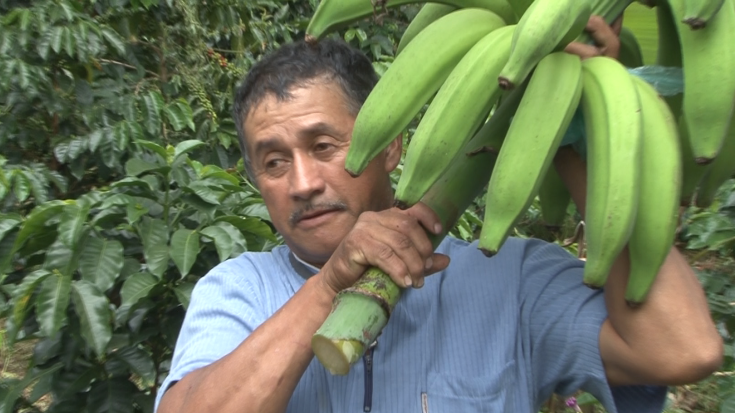With just one cut, a bunch of bananas falls to the ground. One, two, three. Díaz uses a machete to swiftly and expertly cut his banana tree. He slices through the leaves and branches as if they were butter, until nothing is left.
On his farm – La Mariela – close to Pijao in Quindío, Colombia, Díaz has some eight hectares planted with banana and coffee. For Díaz, selling his crops, particularly banana, was difficult because he could not find buyers.
But then he joined the association of Pijao Banana Farmers (Asobplapi), which works under the productive partnership model, a system that functions through contracts with defined prices and quantities. At the departmental level, crops sold under this system end up in large companies such as PepsiCo.
“It is a model where small-scale farmers have guaranteed marketing, where they sell first and then produce. It is a complete change of logic,” says Natalia Gómez, a rural development expert at the World Bank.
The partnership guarantees stable prices. According to Luis Fernando Arias, manager of the Quindío Departmental Association of Banana Producers, farmers used to be at the mercy of middlemen. “Buyers came from Armenia and paid very little for the crop. They told us: I‘ll pay you 4,000 pesos, now cut the bananas!’ and so we did and then they would come and say: ‘No, this banana is no good, I’ll take two for the price of one.’ We had no choice but to give it to them,” says Ricardo Díaz.
With the partnership, farmers also receive technical assistance and supplies, such as fertilizers that they apply in keeping with clean agriculture standards. Through a revolving fund, association members can receive loans to improve their production. They make monthly loan payments. For example, Díaz recalled that he used to produce between 80 and 100 kilos of banana every 15 days but now his yields have increased to between 200 and 300 kilos.
“Previously, we didn’t use fertilizer. Now we do so to produce a good crop,” says Díaz. Farmers must also meet industry standards in terms of quantity, quality, health and delivery times.
Diversification of suppliers
Whereas large enterprises usually prefer to buy crops from large-scale producers for safety reasons, there are advantages to working with small-scale farmers, according to the experts.
“Not all crops can come from large producers. Some, such as coffee and cacao, are typically produced by small-scale farmers,” says Marie-Helene Collion, a rural development specialist. “In Guatemala, vegetables such as green beans can only be grown in the highlands on very small farms and without potential for large trading enterprises.
Additionally, in an environment of climate risk and a high demand for quality food, “agricultural companies are increasingly concerned with guaranteeing their sources so they implement a supplier diversification strategy to build on the potential of small-scale producers,” says Collion.

